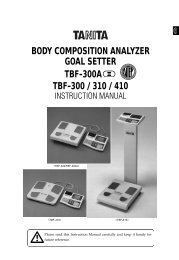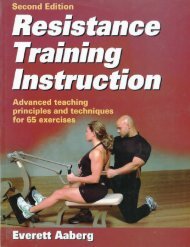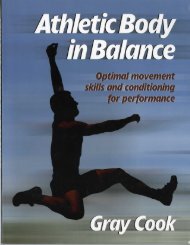By Juan Carlos Santana, MS, CSCS - Gopher Performance
By Juan Carlos Santana, MS, CSCS - Gopher Performance
By Juan Carlos Santana, MS, CSCS - Gopher Performance
You also want an ePaper? Increase the reach of your titles
YUMPU automatically turns print PDFs into web optimized ePapers that Google loves.
STANDING PULLS – Upper bodyStanding pulls are an excellent way to work the total body while emphasizing the posteriorback musculature. They provide balance and stability training while pulling. In real life wealways pull from our feet, therefore, the standing pull is one of the most functional exercises weperform.InstructionsAttach the band or pulley to a low or mid attachment point in front of you. We prefer thelow orientation since it is the most functional. Holding onto the handles, walk back to addappropriate resistance and space for the pulling motion. Stand straight and keep the bodyerect and core tight. Keep knees slightly bent and center of gravity lower then normal. Pull thecables or pulley handles to you as if you were doing a cable row. You can use simultaneous oralternating pulling patterns. We perform anywhere from 3-7 sets X 20-40 reps of this exercisewithin a single workout.Notes:There are several types of pulls you can perform. You can even add a forward reach to the movement, creating a compoundrow. With the alternating version, you can add foot pivots to further focus on hip rotation. The single leg version of thisexercise is also very challenging.EquipmentWe use the Free-Motion mid or low pull (i.e. any machine with a mid or low pulley), the Versa Pulley or heavy JC Bandsfor this exercise. If you don’t have these items, use an adjustable with mid or low orientation from any high quality pulleyor cable system.STANDING PRESSES – Upper bodyStanding presses are an excellent way to work the total body while emphasizing the pressing orpushing motion. This exercise provides balance and stability training while pushing forward.In real life we usually push from a standing position, therefore, the standing press is veryfunctional.InstructionsAttach the band or pulley behind you, from a low or mid attachment point. We prefer the midorientation to emphasize the core and a forward lean position. However, the low orientation iseffective for focusing on the pressing movement. Holding onto the handles, walk forward to add appropriate resistance andspace for the pressing motion. Stand straight and keep the body erect and core tight. We prefer the staggered stance since itprovides more stability to the line of pull. Press the cables or pulley handles as if you were doing a bench press. You can alsouse the alternating pushing pattern, which resembles more a punching action. We perform anywhere from 3-5 sets X 20-40reps of this exercise within a single workout.Notes:There are several types of presses you can perform. You can even add a forward step to the movement, creating a thrustingaction. The single leg version of this exercise is also very challenging.EquipmentWe use the Free-Motion mid or low pull (i.e. any machine with a mid or low pulley), the Versa Pulley or heavy JC Bandsfor this exercise. If you don’t have these items, use any adjustable high quality pulley or cable system with mid or loworientation.
Standing PNF extensionStanding PNF extensions are an excellent multi-planar core exercise. This exercise emphasizesthe extension mechanism, but with a rotational component. Sports, such as tennis and golf,use portions of this movement – making this exercise very popular with our athletes andrecreational sport participants.InstructionsAttach the band or pulley to your side, from a low attachment point. Holding onto one handlewith both hands, walk away from the point of attachment to add appropriate resistance andspace for the extension movement. Stand straight and keep the body erect and core tight. Weprefer the parallel stance since it provides more stability to the line of pull. Keep the armsstraight and locked out in front of your chest. Rotate and flex down towards the point of theattachment, reaching down to load the body. Use a foot pivot on the outside leg during the downward flexion and rotation.This will allow maximum utilization of the entire body. Rotate and extend away from the point of attachment, keeping yourarms locked out and in front of your chest at all times. Pivot on the inside foot as you rotated away from the resistance (seepicture). We perform anywhere from 3-5 sets X 20-40 reps of this exercise within a single workout.Notes:You can also perform the opposite version of this exercise to train rotation and flexion. Use a high orientation of pull andchop downward as you rotate.EquipmentWe use the Free-Motion low pull (i.e. any machine with a low pulley), the Versa Pulley or heavy JC Bands for this exercise.If you don’t have either these items, use an adjustable with mid or low orientation from any high quality pulley or cablesystem.Standing ABC CrunchStanding ABC Crunches offer excellent flexion training for the front of the body, whileaddressing flexibility of the posterior chain. The ABC pattern provides multi-planar training,especially for the hips.InstructionsAttach the band or pulley in front of you, from a mid or high attachment point.Holding on the handles, walk away from the point of attachment to add appropriate resistanceand space for the crunch movement.Stand straight and keep the body erect and core tight. We prefer the parallel stance since it provides more stability for therotational patterns of the ABC.Keep the arms straight and locked out in front of you – at shoulder level.Flex down as if performing a crunch while pulling down and in, until the band touches the shoulders. Come back up to thestanding position. This is the “C” pattern.For the “A” and “B” patterns, flex down as if performing a crunch while rotating and pivoting the foot on the opposite sideof the crunch (see picture). This will bring the bands to the outside of the planted leg. Come back to the standing positionand perform to the other side.The foot pivots during the rotation and flexion really target the hips.We perform anywhere from 3-5 sets X 15-30 reps of this exercise within a single workout.Notes:You can also perform the opposite version of this exercise to train rotation and extension. Use a low point of attachment -pulling and extending as you rotate. Use the same ABC pattern for multi-planar training.EquipmentWe use the Free-Motion mid or high pulley (i.e. any machine with a low pulley), the Versa Pulley or JC Bands for thisexercise. If you don’t have these items, use an adjustable with mid or high orientation from any high quality pulley or cablesystem.







